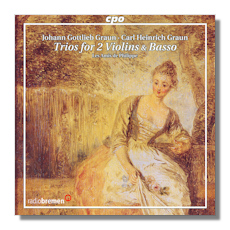
The Internet's Premier Classical Music Source
Related Links
- C.H. Graun Reviews
- Latest Reviews
- More Reviews
-
By Composer
-
Collections
DVD & Blu-ray
Books
Concert Reviews
Articles/Interviews
Software
Audio
Search Amazon
Recommended Links
Site News
 CD Review
CD Review
Trios for Two Violins & Continuo

Johann Gottlieb Graun
Carl Heinrich Graun
- Trio in A Major, GraunWV A:XV:13
- Trio in D Major, GraunWV Cv:XV:100
- Trio in C minor, GraunWV Av:XV:19
- Trio in D Major, GraunWV Av:XV:23
- Trio in E Major, GraunWV Av:XV:27
Les Amis de Philippe
CPO 777423-2
The brothers Johann Gottlieb (1702/3-1771) and Carl Heinrich Graun (1703/4-1759) were well-known and highly praised in their lifetimes; indeed their family's talents survived almost to this day: Vladimir Nabokov (1899-1977) was a great great great grandson. Violinist and singer, respectively, the Grauns held prominent positions in the Prussian court of Frederick II in Berlin after 1740. Although heard less nowadays, they ought to have a following: other recent recordings of Carl Heinrich's distinctive choral music have been well received on Classical Net. From the first notes of this very welcome collection of five Trios for two violins, cello and Hammerflügel (a Hammerclavier for continuo), you know you are in for something special.
There are motifs redolent of Telemann, Handel, Locatelli and even Vivaldi. Yet the progression of musical ideas and invention, which at times almost rushes the listener like a miniature stream grown too bubbly for its banks, never stops. There are changes of pace and melody – but these are not too frequent as to disallow the build up of some very poignant, commanding and co-ordinated musical depth: the allegro of the trio in c (GraunWV Av:XV:19) [tr.10], for example, may at first sound broken, or somewhat wayward in evolution. In fact the members of Les Amis de Philippe (Anne Schumann, violin; Dorothea Vogel, violin; Monika Schwamberger, cello; Ludger Rémy, Hammerflügel) present such a unified and thoroughly-conceived reading as to produce a very satisfying whole. So, Yes, it's music that looks to both classical and Baroque models (including neighbor Quantz). But it's also very much music of its own kind – and with its own considerable strengths, all of which are amply and ably brought out in this recording.
Variety, a controlled restraint and sensitivity to the sound world which the composer creates are also hallmarks of these performances. They are performances, too, where you know the players are in sufficient command to allow much (appropriate) freedom of interpretation, without losing sight of what the composers intended. The opening adagio of the same trio in C minor (GraunWV Av:XV:19) [tr.8], for example, is adventurous and novel; with certainly as much Romantic as Baroque or Classical about it, and strong variations in phrasing and harmony; and a few surprises.
Probably because the Grauns (it's still largely unclear which of the brothers was responsible for what) consciously avoided the Mannheim style that they arrived at a compositional stamp which had as much developmental thrust (at times retaining a polyphonic overlay) as Haydn or Mozart. Yet with a greater degree of entirely unselfconscious virtuosity. There are known to be about three dozen trios reliably attributable to the brothers; in a variety of instrumental combinations. If they are all as pleasing as those presented here, it really is time for greater attention to them.
The trios on this CD, for example, strike a particularly felicitous balance between embellishment and pure tonal and melodic argument. Les Amis de Philippe steer an extremely good course between the two to produce totally integrated accounts of this blend. But they do so in a way that, as each movement ends, you eagerly await the next. Not that the five trios here form any kind of sequence. It's supposed, though, that they represent different stages of the Grauns' compositional careers. Yet all self-standing; each worthy of careful listening on its own terms; not members of a suite or set of publications.
The acoustic is clean and close; just right for the intimate performances, which also hint at something "grander" (the crescendo in the Trio in E (GraunWV Av:XV:27) [tr.15], for example, looks to Italy – Corelli and even Paganini – for some of its flavor). There is a well-produced booklet with informative notes by Ludger Rémy. They also make the case for a reassessment of the Grauns. This is a CD of music of the highest quality, played idiomatically and sensitively (not available elsewhere) by musicians both sympathetic to such a rethink and aware of the extent to which these pleasing trios can otherwise hold their own. Recommended without hesitation not only because the musical conceptions are so fresh, but also because the execution is so accomplished.
Copyright © 2009, Mark Sealey




















